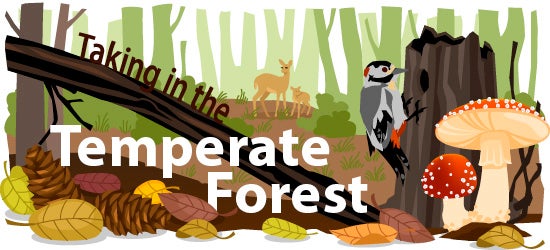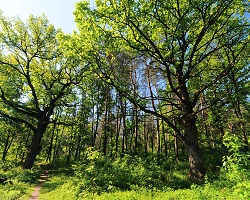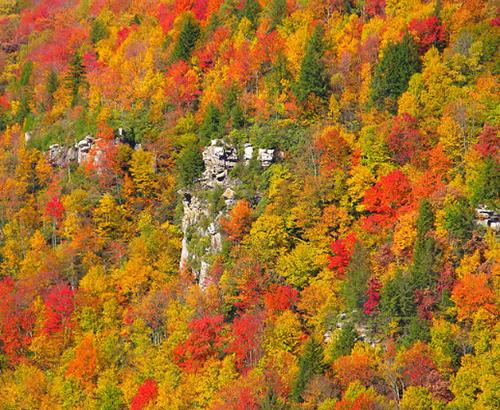
Illustrated by: Sabine Deviche
show/hide words to know
The air is still as you wander through the trees. Leaves slide under your feet and thick tree trunks surround you. Above your head everything is green, as leaves block the sky. You feel twigs crunch under your feet, and mushrooms peek out from under beds of leaves. Somewhere off in the trees you hear the pecking of a woodpecker. All sorts of birds call or fly off as you walk by. You stay quiet and see a deer pass by in the distance. Chances are, you’re in a temperate forest.

In a typical temperate forest, you have large trees, like these oaks, with younger saplings below. Image by Haidamac.
Even if you've spent time in temperate forests, these ecosystems hold many plants and animals that you've likely never seen. In parts of North America, Europe, and Asia, temperate forests used to cover huge areas of land. In several places they still cover large areas, though we've cut down most of the old growth forests.
In Between Biomes
In many ways, temperate forests are in between the other land biomes. In fact, the word temperate means not extreme. They are warmer and more diverse than boreal forests. However, they are not as warm or diverse as rainforests. Temperate forests are also wetter than deserts but drier than rainforests. This is because temperate forests are located in areas that have a mild climate.
Mild climates are mainly found around the mid-latitudes. South American and Australian temperate forests have many plants and animals that are similar, but unrelated, to those in the northern hemisphere’s temperate forests. Temperate forests receive about 30 to 60 inches of precipitation a year. The temperatures are rarely below -20 F (-29 C) or above 90 F (32 C).
Changing Seasons
Temperate forests have four seasons: spring, summer, winter, and fall. Because they are in the mid latitudes of the Earth — not too far south or north — they have a mild climate.

Deciduous trees, like the one the red oak leaf (left) came from, lose their leaves each winter. Coniferous trees keep their needles (right) all winter. Images by Ed Uebel and Mats Halldin.
They have warm summers that are not overly hot like in the deserts further south, during which plants and trees can grow. They also have snowy winters that are not overly cold like in the boreal forests, during which many plants are dormant and many animals migrate or hibernate.
Images via Wikimedia Commons. Autumn forest image by ForestWander.
View Citation

In deciduous temperate forests, many tree leaves change color during autumn before the trees lose their leaves in winter.
![]() Try our Virtual Biomes
Try our Virtual Biomes
Be Part of
Ask A Biologist
By volunteering, or simply sending us feedback on the site. Scientists, teachers, writers, illustrators, and translators are all important to the program. If you are interested in helping with the website we have a Volunteers page to get the process started.







